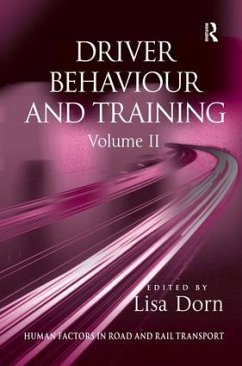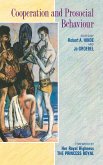Driver Behaviour and Training
Volume 2
Herausgeber: Dorn
Driver Behaviour and Training
Volume 2
Herausgeber: Dorn
- Gebundenes Buch
- Merkliste
- Auf die Merkliste
- Bewerten Bewerten
- Teilen
- Produkt teilen
- Produkterinnerung
- Produkterinnerung
The objective of this second edition is to describe and discuss recent advances in the study of driving behaviour and driver training. It bridges the gap between practitioners in road safety, and theoreticians investigating driving behaviour, from a number of different perspectives and related disciplines
Andere Kunden interessierten sich auch für
![Suicide Suicide]() Emile DurkheimSuicide136,99 €
Emile DurkheimSuicide136,99 €![Thinking on Housing Thinking on Housing]() Peter KingThinking on Housing79,99 €
Peter KingThinking on Housing79,99 €![Sustainability and the City Sustainability and the City]() Sustainability and the City157,99 €
Sustainability and the City157,99 €![The Welland Canals and Their Communities The Welland Canals and Their Communities]() John JacksonThe Welland Canals and Their Communities94,99 €
John JacksonThe Welland Canals and Their Communities94,99 €![Food Safety Management in China: A Perspective from Food Quality Control System Food Safety Management in China: A Perspective from Food Quality Control System]() Jiehong ZhouFood Safety Management in China: A Perspective from Food Quality Control System100,99 €
Jiehong ZhouFood Safety Management in China: A Perspective from Food Quality Control System100,99 €![Families Mental Health and Challenges in the 21st Century Families Mental Health and Challenges in the 21st Century]() Families Mental Health and Challenges in the 21st Century153,99 €
Families Mental Health and Challenges in the 21st Century153,99 €![Cooperation and Prosocial Behaviour Cooperation and Prosocial Behaviour]() A. Hinde / Jo Groebel (eds.)Cooperation and Prosocial Behaviour184,99 €
A. Hinde / Jo Groebel (eds.)Cooperation and Prosocial Behaviour184,99 €-
-
-
The objective of this second edition is to describe and discuss recent advances in the study of driving behaviour and driver training. It bridges the gap between practitioners in road safety, and theoreticians investigating driving behaviour, from a number of different perspectives and related disciplines
Hinweis: Dieser Artikel kann nur an eine deutsche Lieferadresse ausgeliefert werden.
Hinweis: Dieser Artikel kann nur an eine deutsche Lieferadresse ausgeliefert werden.
Produktdetails
- Produktdetails
- Verlag: Taylor & Francis
- Seitenzahl: 528
- Erscheinungstermin: 27. Oktober 2005
- Englisch
- Abmessung: 234mm x 156mm x 29mm
- Gewicht: 912g
- ISBN-13: 9780754644309
- ISBN-10: 0754644308
- Artikelnr.: 45435505
- Herstellerkennzeichnung
- Libri GmbH
- Europaallee 1
- 36244 Bad Hersfeld
- gpsr@libri.de
- Verlag: Taylor & Francis
- Seitenzahl: 528
- Erscheinungstermin: 27. Oktober 2005
- Englisch
- Abmessung: 234mm x 156mm x 29mm
- Gewicht: 912g
- ISBN-13: 9780754644309
- ISBN-10: 0754644308
- Artikelnr.: 45435505
- Herstellerkennzeichnung
- Libri GmbH
- Europaallee 1
- 36244 Bad Hersfeld
- gpsr@libri.de
Dr. Lisa Dorn
1: Driver Training and Education
1: Interactive Scenario Modelling for Hazard Perception in Driver Training
2: An Analysis of the National Driver Improvement Scheme by Referral Type
3: Assessment of Driving Training Courses
4: Driver Education BSM Driving Instructor Training Programme
5: Should Driver Education Include Training Against Instinctive Human Reactions?
6: Cars, Sex, Drugs and Media: Comparing Modalities of Road Safety and Public Health Messages
2: Simulation and In-Vehicle Technology
7: Novice Driver Performance Improvement with Simulator Training
8: Truck and Bus Driver Training, Can Simulation Contribute?
9: The Potential to Enhance Older Drivers' Critical Driving Skills Through Simulator-Based Advice
10: Microsimulation of Traffic for Safety Study of In-Vehicle Intelligent Transportation Systems
11: Assessing Drivers' Level of Trust in Adaptive Cruise Control and Their Conceptual Models of the System: Implications for System Design
3: Young Driver Behaviour and Road Safety
12: Driver Education - A Difficult but Possible Safety Measure
3: Identifying Young Driver Subtypes: Relationship to Risky Driving and Crash Involvement
14: Development and First Evaluation of a Prediction Model for Risk of Offences and Accident Involvement Among Young Drivers
15: Assessment of a Diary to Study Development of Higher-Order-Skills During Driving Experience
16: Young Drivers' Attitudes Towards Risks Arising from Hazardous Driving Behaviours
17: Prediction of Driving Accident Risk in Novice Drivers in Ontario: The Development of a Screening Instrument
18: Seat-Belt Use by Spanish Adolescents
4: Vulnerable Road Users
19: Designing Powered Two Wheeler Training to Match Rider Goals
20: Understanding the Increasing Trend of Motorcycle Fatalities: Rider Error, Driver Error or Training Error?
21: Driving at Fifteen: Assessment of Moped Rider Training Among Teens
22: Vulnerable Road User Safety: Social Interaction on the Road?
5: Personality, Emotions and Driving
23: The Transactional Model of Driver Stress and Fatigue and its Implications for Driver Training
24: A Cross-Cultural Comparison of the Driving Anger Scale
25: The Effect of Sensation-Seeking on Driver Fatigue
26: The Use of Group Dynamics in a Driver Rehabilitation Course
6: At-Work Road Safety
27: Factors Influencing the Behaviour of People Who Drive at Work
28: A Qualitative Analysis of Company Car Driver Road Safety
29: Development of the Police Driver Risk Index
30: Fatigue-Related Driver Behaviour in Untrained and Professional Drivers
31: Predictors of Coach Drivers' Safety Behaviour and Health Status
32: Comparing IT-Based Driver Assessment Results Against Self-Reported and Actual Crash Outcomes in a Large Motor Vehicle Fleet
33: Differential Accident Involvement of Bus Drivers
34: The Safety Value of Driver Education in Nigeria: An Assessment of Professional Driver Behaviour
7: Crash Analysis
35: The Application of Systems Engineering Techniques to the Modelling of Crash Causation
36: The Application of Accident Script Analysis to Truck Crashes
37: Non-Linear Methods for the Identification of Drivers at Risk to Cause Accidents
8: Driver Attention and Knowledge
38: Use of the d2 Test of Attention as a Predictor of Driving Proficiency
39: Mental Models and Attentional Processes in Car Driving
40: What Drivers Don't Know
41: Transfer of Useful Field of Vision from Team Sports to Driving Skills in a Simulated Driving Test
Conclusion
Driver Coaching: Driving Standards Higher
1: Interactive Scenario Modelling for Hazard Perception in Driver Training
2: An Analysis of the National Driver Improvement Scheme by Referral Type
3: Assessment of Driving Training Courses
4: Driver Education BSM Driving Instructor Training Programme
5: Should Driver Education Include Training Against Instinctive Human Reactions?
6: Cars, Sex, Drugs and Media: Comparing Modalities of Road Safety and Public Health Messages
2: Simulation and In-Vehicle Technology
7: Novice Driver Performance Improvement with Simulator Training
8: Truck and Bus Driver Training, Can Simulation Contribute?
9: The Potential to Enhance Older Drivers' Critical Driving Skills Through Simulator-Based Advice
10: Microsimulation of Traffic for Safety Study of In-Vehicle Intelligent Transportation Systems
11: Assessing Drivers' Level of Trust in Adaptive Cruise Control and Their Conceptual Models of the System: Implications for System Design
3: Young Driver Behaviour and Road Safety
12: Driver Education - A Difficult but Possible Safety Measure
3: Identifying Young Driver Subtypes: Relationship to Risky Driving and Crash Involvement
14: Development and First Evaluation of a Prediction Model for Risk of Offences and Accident Involvement Among Young Drivers
15: Assessment of a Diary to Study Development of Higher-Order-Skills During Driving Experience
16: Young Drivers' Attitudes Towards Risks Arising from Hazardous Driving Behaviours
17: Prediction of Driving Accident Risk in Novice Drivers in Ontario: The Development of a Screening Instrument
18: Seat-Belt Use by Spanish Adolescents
4: Vulnerable Road Users
19: Designing Powered Two Wheeler Training to Match Rider Goals
20: Understanding the Increasing Trend of Motorcycle Fatalities: Rider Error, Driver Error or Training Error?
21: Driving at Fifteen: Assessment of Moped Rider Training Among Teens
22: Vulnerable Road User Safety: Social Interaction on the Road?
5: Personality, Emotions and Driving
23: The Transactional Model of Driver Stress and Fatigue and its Implications for Driver Training
24: A Cross-Cultural Comparison of the Driving Anger Scale
25: The Effect of Sensation-Seeking on Driver Fatigue
26: The Use of Group Dynamics in a Driver Rehabilitation Course
6: At-Work Road Safety
27: Factors Influencing the Behaviour of People Who Drive at Work
28: A Qualitative Analysis of Company Car Driver Road Safety
29: Development of the Police Driver Risk Index
30: Fatigue-Related Driver Behaviour in Untrained and Professional Drivers
31: Predictors of Coach Drivers' Safety Behaviour and Health Status
32: Comparing IT-Based Driver Assessment Results Against Self-Reported and Actual Crash Outcomes in a Large Motor Vehicle Fleet
33: Differential Accident Involvement of Bus Drivers
34: The Safety Value of Driver Education in Nigeria: An Assessment of Professional Driver Behaviour
7: Crash Analysis
35: The Application of Systems Engineering Techniques to the Modelling of Crash Causation
36: The Application of Accident Script Analysis to Truck Crashes
37: Non-Linear Methods for the Identification of Drivers at Risk to Cause Accidents
8: Driver Attention and Knowledge
38: Use of the d2 Test of Attention as a Predictor of Driving Proficiency
39: Mental Models and Attentional Processes in Car Driving
40: What Drivers Don't Know
41: Transfer of Useful Field of Vision from Team Sports to Driving Skills in a Simulated Driving Test
Conclusion
Driver Coaching: Driving Standards Higher
1: Driver Training and Education
1: Interactive Scenario Modelling for Hazard Perception in Driver Training
2: An Analysis of the National Driver Improvement Scheme by Referral Type
3: Assessment of Driving Training Courses
4: Driver Education BSM Driving Instructor Training Programme
5: Should Driver Education Include Training Against Instinctive Human Reactions?
6: Cars, Sex, Drugs and Media: Comparing Modalities of Road Safety and Public Health Messages
2: Simulation and In-Vehicle Technology
7: Novice Driver Performance Improvement with Simulator Training
8: Truck and Bus Driver Training, Can Simulation Contribute?
9: The Potential to Enhance Older Drivers' Critical Driving Skills Through Simulator-Based Advice
10: Microsimulation of Traffic for Safety Study of In-Vehicle Intelligent Transportation Systems
11: Assessing Drivers' Level of Trust in Adaptive Cruise Control and Their Conceptual Models of the System: Implications for System Design
3: Young Driver Behaviour and Road Safety
12: Driver Education - A Difficult but Possible Safety Measure
3: Identifying Young Driver Subtypes: Relationship to Risky Driving and Crash Involvement
14: Development and First Evaluation of a Prediction Model for Risk of Offences and Accident Involvement Among Young Drivers
15: Assessment of a Diary to Study Development of Higher-Order-Skills During Driving Experience
16: Young Drivers' Attitudes Towards Risks Arising from Hazardous Driving Behaviours
17: Prediction of Driving Accident Risk in Novice Drivers in Ontario: The Development of a Screening Instrument
18: Seat-Belt Use by Spanish Adolescents
4: Vulnerable Road Users
19: Designing Powered Two Wheeler Training to Match Rider Goals
20: Understanding the Increasing Trend of Motorcycle Fatalities: Rider Error, Driver Error or Training Error?
21: Driving at Fifteen: Assessment of Moped Rider Training Among Teens
22: Vulnerable Road User Safety: Social Interaction on the Road?
5: Personality, Emotions and Driving
23: The Transactional Model of Driver Stress and Fatigue and its Implications for Driver Training
24: A Cross-Cultural Comparison of the Driving Anger Scale
25: The Effect of Sensation-Seeking on Driver Fatigue
26: The Use of Group Dynamics in a Driver Rehabilitation Course
6: At-Work Road Safety
27: Factors Influencing the Behaviour of People Who Drive at Work
28: A Qualitative Analysis of Company Car Driver Road Safety
29: Development of the Police Driver Risk Index
30: Fatigue-Related Driver Behaviour in Untrained and Professional Drivers
31: Predictors of Coach Drivers' Safety Behaviour and Health Status
32: Comparing IT-Based Driver Assessment Results Against Self-Reported and Actual Crash Outcomes in a Large Motor Vehicle Fleet
33: Differential Accident Involvement of Bus Drivers
34: The Safety Value of Driver Education in Nigeria: An Assessment of Professional Driver Behaviour
7: Crash Analysis
35: The Application of Systems Engineering Techniques to the Modelling of Crash Causation
36: The Application of Accident Script Analysis to Truck Crashes
37: Non-Linear Methods for the Identification of Drivers at Risk to Cause Accidents
8: Driver Attention and Knowledge
38: Use of the d2 Test of Attention as a Predictor of Driving Proficiency
39: Mental Models and Attentional Processes in Car Driving
40: What Drivers Don't Know
41: Transfer of Useful Field of Vision from Team Sports to Driving Skills in a Simulated Driving Test
Conclusion
Driver Coaching: Driving Standards Higher
1: Interactive Scenario Modelling for Hazard Perception in Driver Training
2: An Analysis of the National Driver Improvement Scheme by Referral Type
3: Assessment of Driving Training Courses
4: Driver Education BSM Driving Instructor Training Programme
5: Should Driver Education Include Training Against Instinctive Human Reactions?
6: Cars, Sex, Drugs and Media: Comparing Modalities of Road Safety and Public Health Messages
2: Simulation and In-Vehicle Technology
7: Novice Driver Performance Improvement with Simulator Training
8: Truck and Bus Driver Training, Can Simulation Contribute?
9: The Potential to Enhance Older Drivers' Critical Driving Skills Through Simulator-Based Advice
10: Microsimulation of Traffic for Safety Study of In-Vehicle Intelligent Transportation Systems
11: Assessing Drivers' Level of Trust in Adaptive Cruise Control and Their Conceptual Models of the System: Implications for System Design
3: Young Driver Behaviour and Road Safety
12: Driver Education - A Difficult but Possible Safety Measure
3: Identifying Young Driver Subtypes: Relationship to Risky Driving and Crash Involvement
14: Development and First Evaluation of a Prediction Model for Risk of Offences and Accident Involvement Among Young Drivers
15: Assessment of a Diary to Study Development of Higher-Order-Skills During Driving Experience
16: Young Drivers' Attitudes Towards Risks Arising from Hazardous Driving Behaviours
17: Prediction of Driving Accident Risk in Novice Drivers in Ontario: The Development of a Screening Instrument
18: Seat-Belt Use by Spanish Adolescents
4: Vulnerable Road Users
19: Designing Powered Two Wheeler Training to Match Rider Goals
20: Understanding the Increasing Trend of Motorcycle Fatalities: Rider Error, Driver Error or Training Error?
21: Driving at Fifteen: Assessment of Moped Rider Training Among Teens
22: Vulnerable Road User Safety: Social Interaction on the Road?
5: Personality, Emotions and Driving
23: The Transactional Model of Driver Stress and Fatigue and its Implications for Driver Training
24: A Cross-Cultural Comparison of the Driving Anger Scale
25: The Effect of Sensation-Seeking on Driver Fatigue
26: The Use of Group Dynamics in a Driver Rehabilitation Course
6: At-Work Road Safety
27: Factors Influencing the Behaviour of People Who Drive at Work
28: A Qualitative Analysis of Company Car Driver Road Safety
29: Development of the Police Driver Risk Index
30: Fatigue-Related Driver Behaviour in Untrained and Professional Drivers
31: Predictors of Coach Drivers' Safety Behaviour and Health Status
32: Comparing IT-Based Driver Assessment Results Against Self-Reported and Actual Crash Outcomes in a Large Motor Vehicle Fleet
33: Differential Accident Involvement of Bus Drivers
34: The Safety Value of Driver Education in Nigeria: An Assessment of Professional Driver Behaviour
7: Crash Analysis
35: The Application of Systems Engineering Techniques to the Modelling of Crash Causation
36: The Application of Accident Script Analysis to Truck Crashes
37: Non-Linear Methods for the Identification of Drivers at Risk to Cause Accidents
8: Driver Attention and Knowledge
38: Use of the d2 Test of Attention as a Predictor of Driving Proficiency
39: Mental Models and Attentional Processes in Car Driving
40: What Drivers Don't Know
41: Transfer of Useful Field of Vision from Team Sports to Driving Skills in a Simulated Driving Test
Conclusion
Driver Coaching: Driving Standards Higher








